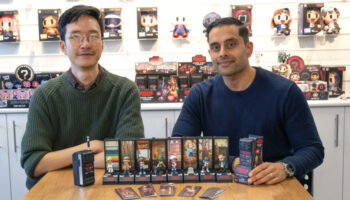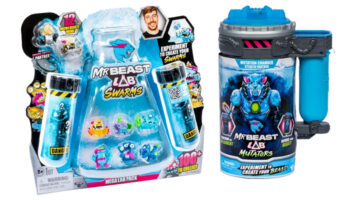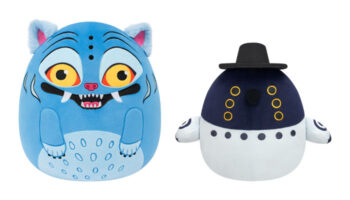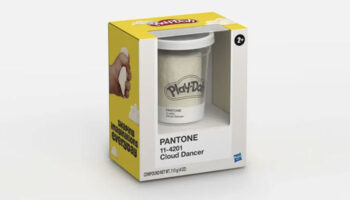Funko Games’ Josh Manderville and Deirdre Cross on bringing a kinetic energy to the tabletop in Fast & Furious: Highway Heist

The world of Fast & Furious has landed in the tabletop space thanks to the team at Funko Games.
Based on the blockbuster movie series, Fast & Furious: Highway Heist sees players step into the shoes of characters from the films to take on heavily-armed enemies with their hot cars and pull off daring vehicle-to-vehicle leaps of faith.
To dive into the process behind bringing Fast & Furious into board games – and get the low-down on the firm’s upcoming Seinfeld and ESPN titles – we caught up with Deirdre Cross, VP at Funko Games, and Josh Manderville, Art Director at Funko Games.

Deirdre, Josh – thanks so much for making time… Josh, let’s kick off with you as we’ve not chatted before, how did you find yourself in the board game space? Was it always in the cards or did you sneak in through a side-door?
Josh Manderville, Art Director, Funko Games: It was kind of a side-door! I started in print ads for local newspapers. I also worked in print shops doing business cards, envelopes, stationary – whatever local businesses needed. On the side, a lot of my friends were in bands, so I’d do also show posters and flyers.
I heard about an opening at a small company called Privateer Press, they are the company behind the game Warmachine. The art director had a background in punk music and had seen my posters, so he granted me an interview to be an assistant graphic designer there. I was there for nine years and learned a lot about hobby gaming, the complexities of hitting deadlines on board games and budgets and managing design teams. It was a great experience.
I ventured outside of that and did a brief stint at Pokémon working on packaging as a contractor, and I’d always been in touch with Forrest-Pruzan Creative (our game design studio that was acquired by Funko). I’d helped out on projects as a contractor and eventually an opportunity came up to join the team.
Have you seen the role of art director at games companies evolve in the time since you’ve been in the games industry?
JM: The ease of ability for artists to become more familiar with illustration software – Procreate being a very friendly app for any artist to learn – has opened the doors. It means the games industry can find really great artists to help them tell these stories.
Board games are experiential design pieces. You’re not just slapping great art onto something and hoping the art sells it – you want people to be immersed in a world when they’re playing. Art is becoming more useful for everyone in the board game space to help them flesh this stuff out.
Absolutely – and with hobby games, lots of consumers follow artists as much as they follow designers in some cases. So how do you and Deirdre work together? What does that relationship between art and gameplay look like at Funko Games?
JM: When trying to get everyone on the same page with an idea, we’ll often start with mood boards. It’s about digging into the art history of a given project. Say we’re working with a licence, we’ll look at what originally inspired that brand or art movements related to that. We’ll then use those mood boards as a guide moving forward.
Deirdre Cross, VP at Funko Games: Our process is almost osmotic! The design of the gameplay and the graphic design is really integrated. I also come in with a view of how much can we afford – those kinds of questions. It all informs each other.
The global pandemic has presented new challenges for us. Our process is very collaborative; we thrive when we can all get in one room with our scrappy prototypes and mood boards. You can see the vision all coming together. It’s an integrated dance between the different parts of the team that gets us to a final product.
In our past, we worked with publishers where you create a game and throw it over the fence to the art department, but that’s not us – we’re very collaborative.
JM: Yes, it’s not like my department hands something to Deirdre’s department. There’s no accountability ladder. Instead, it’s all about how we can create something as a collective, creative group of people.

Great stuff! Now let’s dive into your latest game – Fast & Furious: Highway Heist. First off, most people will know the franchise, so how does this play?
DC: Fast & Furious: Highway Heist is a co-operative game where you’ll play as one of the iconic characters from the Fast and Furious franchise, you’ll also get pick a car; each vehicle has its own special abilities. The game itself can be played across three different scenarios, and you do all the crazy stuff you see in the films – you can play cards to drive under a semi or jump on the back of it or throw cargo to a teammate on a moving car.
When you think about the speed of these movies, it’s crazy to think about translating that into a board game! The juxtaposition between the two is part of what we love about it, but you really do feel like you’re performing a heist! Mechanically, It’s very different than any other game that I’ve played. We developed – with Josh’s art direction – a very cool mechanism where the cards move alongside the board as you’re playing to create a sense of movement.
It’s high-energy for a tabletop game, and it’s been interesting to translate something of that scale, speed and energy into a tabletop experience. Also, because of the co-op nature of the game, it plays extremely well over Zoom!
JM: During the development, one thing that came up was those scenes in the movies where the characters plan the heist. Usually they’re in a room – much like a game room – trying to figure out how to pull of the heist, and I think the game also captures that aspect of the franchise too.
Also, it’s fun to play with little toys on a board!

Absolutely! The Fast & Furious brand has evolved over the years and it has lots of different facets – cars, racing, memorable characters, stunts, spy stuff! It’s becoming live-action Looney Tunes! With so many strings to pull at to get a sense of the brand, where did you start?
DC: When we’re starting on something, it’s all about foundational research. We got the whole team that was working on it to watch all the films. We digest it and then think about how it made us feel – that’s our driving force all the time.
With nine films in the franchise, we obviously couldn’t include all of the story points, so we wanted to create something that felt like the whole franchise. It was amazing working with Universal, who are a really terrific partner. They supported us in creating a new entertainment experience that has the same vibe as the whole franchise.
JM: There’s a bit more work with brands like this when we’re researching things. We start with the touchstones, and for me, that was old hot rod movies: Dragstrip Riot, Vanishing Point, Death Race 2000… Those films have a different vibe than Fast & Furious, but they’re still daredevil action movies with a lot of speed. We knew the game had to have thrilling stunts, because it’s not just about people driving cars – they get out of their cars, jump on top of tanks and things like that!
You’re also dealing with movies that started in one era and are still being made, so – stylistically – the films look very different. You start with hyper-neon street racing and they have progressively become hyper stylized. Things become more abstracted as they go, so it wasn’t about capturing specific actors doing specific things, it was more about evoking the cars and the characters. And like Deirdre said, capturing the movement of those films was key. It all moves a million miles an hour.

On the art direction side of things, do you like projects like this where there’s scope to go in lots of different directions, or do you prefer projects where a brand’s style has already been cemented, like Pan Am for example?
JM: For me, I enjoy parameters. Sometimes, things that are a bit more open world can be challenging, because your creativity is unbound, and you can go in a million different directions.
Look at Back to the Future. It’s a movie we all know and love, it takes place in the Fifties and we know what’s been done with it before. The constraints are that it has to represent an era but doesn’t necessarily have to be exactly like you’ve just pulled that era out of a time machine. Those kind of boundaries in design are good for creativity.
Now, I’m a huge Seinfeld fan so I can’t let you go without asking about your new game Seinfeld: The Party Game About Nothing…
DC: Oh my gosh Billy – if anyone from the team wasn’t a fan of the show before we started working on this project, they are now! It has questions from all 180 episodes of the show and coincidentally, our main artist on Fast & Furious: Highway Heist also did our Seinfeld game!

Every card has an illustration and a question about the picture, but it also has other categories like acting things out and guessing who said certain quotes. You may even have to do your best Elaine dance! Some trivia games are quite sedate; you drink some wine and just sit there. But with this, you’ll dance around and act like Newman too! It’s a lot of fun.
And I am right in thinking there’s even a Marble Rye challenge?
DC: Yes! If you reach a certain number of points, you can fish for the marble rye for the win. It’s crazy!

JM: It unlocks lots of memories of episodes you might have forgotten about.
DC: And while some people may be superfans like you Billy, other people might be more casual fans, like my husband, so by creating a Seinfeld experience that isn’t just trivia, it ensures that there’s parity between players. We don’t want to leave anyone out because they haven’t seen all 180 episodes.
Smart! And did this come about as part of Funko’s wider Seinfeld range, or was this already in the works?
DC: We’d been wanting to make a Seinfeld game for 20 years! Games usually have a longer lead time than the other parts of the business, so we start our process early. We heard rumblings that Seinfeld was going to be unlocked for Funko and we began working right away. When we knew that Funko had official confirmation on the licence, our team had already hit the ground running and had been talking with Warner Bros about what we could do!
Sticking with ‘trivia’, you also have an ESPN trivia game – was it key to make that more of an experience than strictly trivia?
DC: Yes, exactly! Not everyone’s an expert in field hockey! It has a great drafting mechanic at the start of the game to decide what teams have to answer or do. If you’re bad at trivia, but great at bar games, there’s also a mini football goal post, ice hockey net, baseball strike zone and basketball hoop so you can perform dexterity challenges within the game.

Sounds like a sports game I can get on with! Last question, before we go – and I’ve asked Deirdre this before so this one’s for you Josh – how do you fuel your creativity?
JM: I’ve painted since I was a kid and I sculpt as well. In the last year, I’ve got more into physical fitness and using that as creative thinking time. It’s an opportunity to unload ideas and contemplate what I’m working on. I also decided to learn more about music – it’s a creative avenue in something that I’m not as adept with. It’s been fun to find new ways to refresh my creativity.
Great stuff. Guys, it’s always a pleasure. Thanks again and hopefully we’ll speak again soon!
—
To stay in the loop with the latest news, interviews and features from the world of toy and game design, sign up to our weekly newsletter here
























